Netac Z5 USB 3.1 Gen 2 Portable SSD Review
by Ganesh T S on August 9, 2016 8:00 AM ESTPerformance Consistency
The typical problem with high-speed passively-cooled DAS units is performance consistency. This may be influenced by thermal throttling and firmware caps on access rates to avoid overheating or other similar scenarios. This aspect is an important one, as the last thing that users want to see when copying over, say, 100 GB of data to the DAS unit, is the transfer rate going to USB 2.0 speeds. In order to identify whether the unit under test suffers from this problem, we instrumented our robocopy DAS benchmark suite to record the drive's read and write transfer rates while the robocopy process took place in the background. For supported drives, we also recorded the internal temperature of the drive during the process. The Netac Z5, unfortunately, doesn't support temperature read-out. The graph below show the speeds observed during our real-world DAS suite processing. The first three sets of writes and reads correspond to the photos suite. A small gap (for the transfer of the videos suite from the primary drive to the RAM drive) is followed by three sets for the next data set. Another small RAM-drive transfer gap is followed by three sets for the Blu-ray folder.
An important point to note here is that each of the first three blue and green areas correspond to 15.6 GB of writes and reads respectively. Throttling, if any, is apparent within the processing of the photos suite itself.
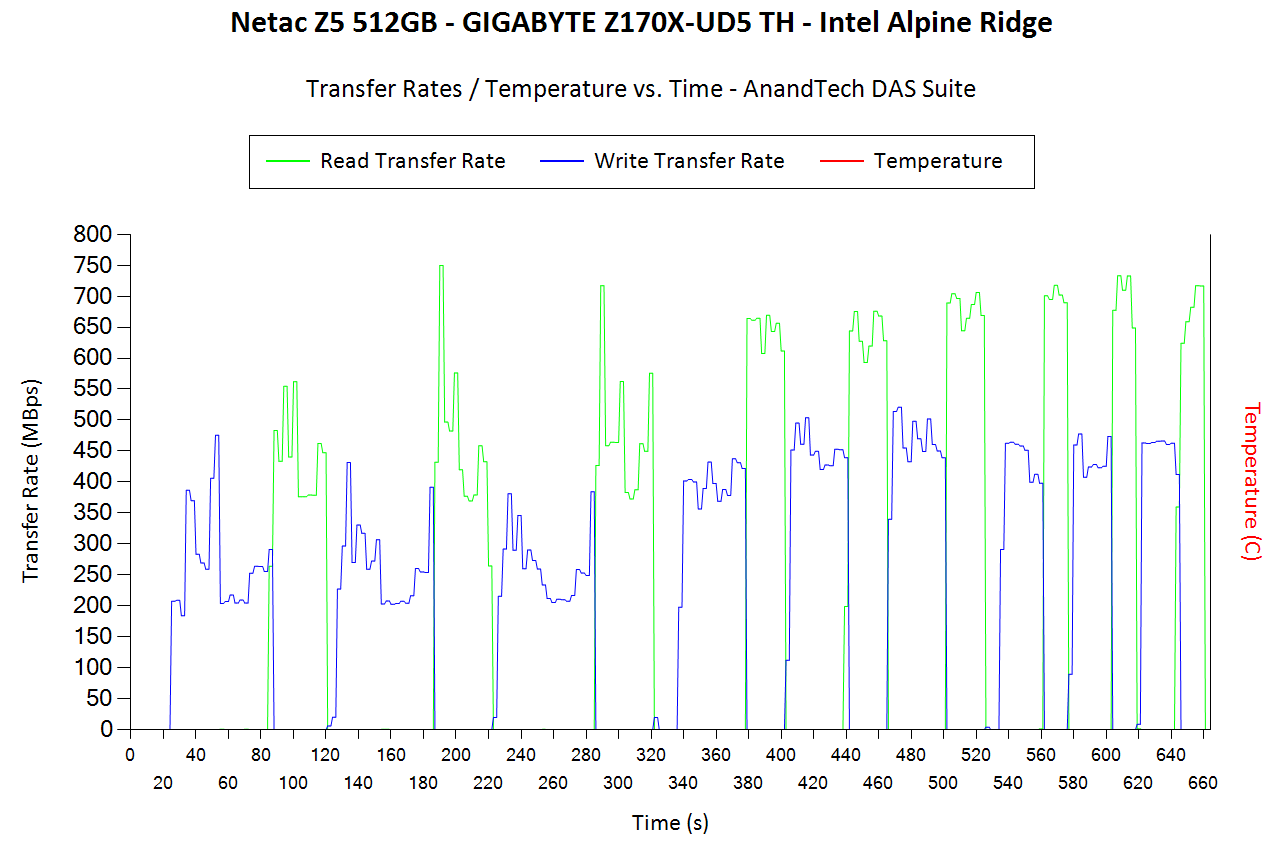
We do not see any performance consistency issues with the Netac Z5 at all.
Power Consumption
The power consumed by the Netac Z5 512GB SSD was measured under multiple scenarios using Plugable's USBC-TKEY power delivery sniffer. These scenarios were triggered using CrystalDiskMark 5.1.2 x64 with a 8GB test file and each test separated by a 30s interval. The initial part of the graphs below show the idle power consumption of the drive. This is followed by the power consumed when CrystalDiskMark prepares the 8GB test file on the drive. The eight distinct segments that follow show the power consumption profile for the workloads (single-threaded sequential and random accesses with a queue depth of 32, followed by sequential and random accesses with a queue depth of 1). The first four segments correspond to read accesses and the last four to write accesses.
The idling power consumption during this testing was observed to be 1.88 W, while the peak power consumption was 7.85 W.
We also tracked the bus power consumption while processing the AnandTech DAS Suite (both the robocopy benchmarks as well as the PCMark 8 storage traces).
In this scenarion, the idling and peak power consumption numbers were observed to be 1.87W and 7.76 W respectively.
Thermal Design
The absence of thermal throttling in the course of our DAS suite processing made us curious about the actual thermal behavior of the unit. Given that we had no way to track the internal SSDs' temperature, we opted to take thermal pictures of the exterior metal surface (using the FLIR One Thermal Imager for Android) after finishing the processing of our robocopy benchmarks (around the 1000s mark in the power consumption graph above).
We recorded temperatures of approximately 48C and 46C on either side. It is not very dangerous, but one should definitely expect the metal surface to become quite warm after subjecting the SSD to strenuous traffic.
In terms of actual thermal design, we were quite surprised to find that neither the SSD controllers nor the flash packages had any sort of thermal pad to aid in transferring the generated heat to the metal body. This means that the metal surface takes some time to heat up, but, the controller and flash temperatures could become unreasonably warm in the meanwhile. That said, we don't see that being a problem for typical DAS workloads.


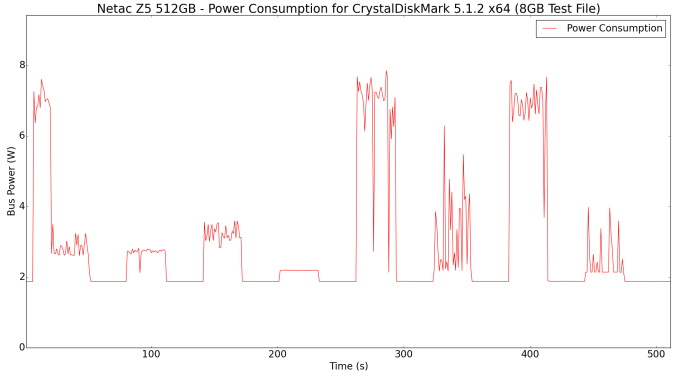
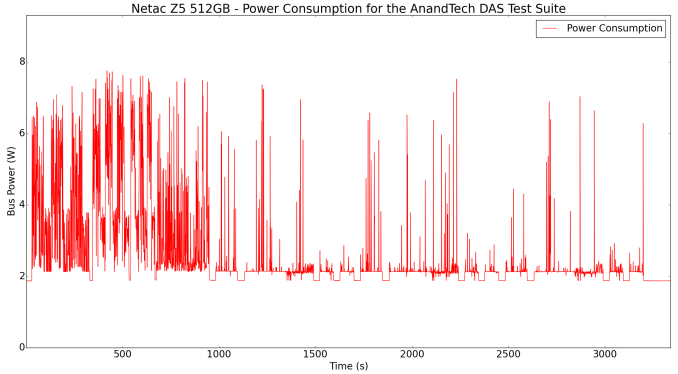
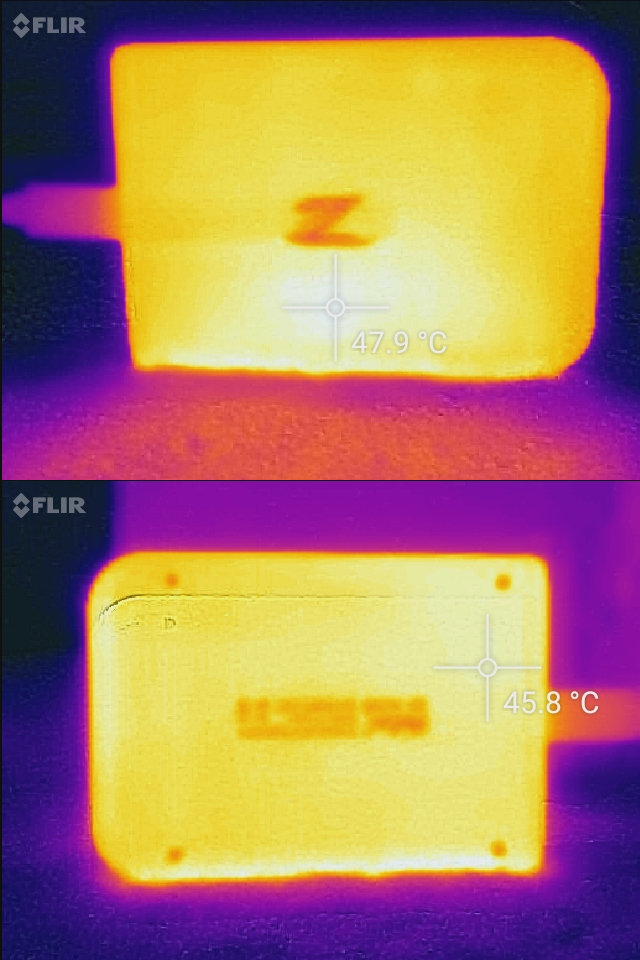
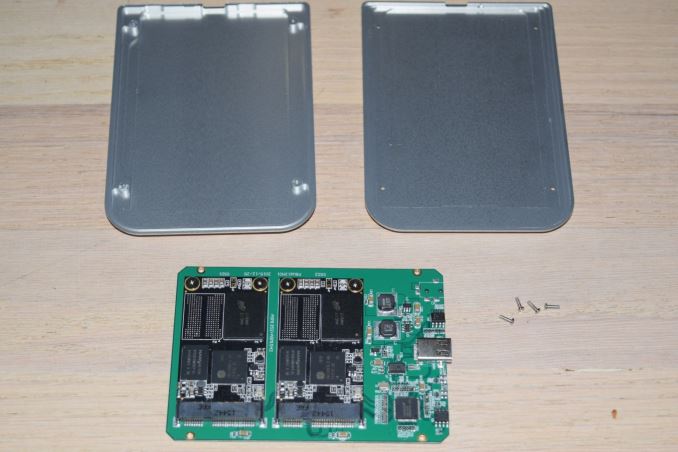








22 Comments
View All Comments
BrokenCrayons - Wednesday, August 10, 2016 - link
The skin temp of the Netac case was 46C. By the time heat reaches the exterior and is measured by an IR camera, it's dispersed from the sources that are creating it. This implies the internal temps experienced by the flash storage inside is higher. The good news is the Netac isn't throttling due to temperature as is made clear by the review. The temps measured were under atypically high demand too so day-to-day file copies wouldn't likely create that situation. However, since Ganesh has pointed out the company is aware of the thermal performance as a shortcoming, I think being dismissive of thermal concerns might be a mistake.Samus - Wednesday, August 10, 2016 - link
It's true using thermal pads to mate the controllers to the chassis will improve thermals, but if the drive isn't throttling, it is within design specifications, which means according to the manufacture reliability wont be sacrificed. So Netac concerning themselves with the thermals is superficial, and anything they do to improve them is a solution looking for a problem.I don't like my gadgets hot anymore than the next guy, but sometimes that's just how they are designed.
LordConrad - Tuesday, August 9, 2016 - link
"ASMedia's custom drivers for ASM1142 are no longer needed, given that Windows 10 bundles a Microsoft USB 3.1 xHCI driver."You should not assume that everyone is using Windows 10.
Samus - Tuesday, August 9, 2016 - link
Why aren't you using Windows 10? It was free for a whole year. Free!KingofL337 - Tuesday, August 9, 2016 - link
Would you really be willing to trust your data to some fly by night company? I can understand it's fast bust still.ganeshts - Tuesday, August 9, 2016 - link
I would hardly call Netac a 'fly by night' company given their background.Btw, if we even have a little bit of inkling / doubt that some vendor is a 'fly by night' operation, we would definitely NOT be reviewing their wares.
KingofL337 - Wednesday, August 10, 2016 - link
Maybe, 'fly by night' if the wrong wording how about 'unproven'.it looks like they took a reference design for the SM2246EN and slapped or will slap a set of the cheapest mSATA drives to the board. They aren't using their flash or Dram. They aren't available in the US except Amazon and they sell mostly cheap USB drives, uSD cards and a few HDDs with almost no reviews. Googling them basically shows their page, Amazon and this review.
These comments sure makes me feel warm inside.
Never been reviewed before or almost anyone else.
Prior to going into the specifics of the Netac Z5, a few words about Netac are in order, as none of their products have been reviewed by us before.
Not their own Flash, Dram or Controller
They use the Silicon Motion SM2246EN controller with Nanya DRAM and Micron NAND flash. Based on the package markings, it appears that the mSATA SSDs are using Micron MLC flash.
No Trim on a SSD, so this things is going to slow to a crawl.
TRIM support is shown in the information view, but, it is not possible to activate it behind the bridge chip.
No attempt at a thermal solution
In terms of actual thermal design, we were quite surprised to find that neither the SSD controllers nor the flash packages had any sort of thermal pad to aid in transferring the generated heat to the metal body.
Also these Chinese companies are adding no R&D effort slapping together or borrowing the design of these drives and marking them down a little and selling them. We put our data on them and they fail and so does all our data. We would never by a spinning disc made by a company like this.
ganeshts - Wednesday, August 10, 2016 - link
Other than Samsung, SanDisk and Micron / Crucial - who makes their own flash, DRAM or controller?So, if a company well-established in the Chinese market wants to get a presence / enter into the US market, does one immediately dismiss them because they haven't been reviewed by anyone in the US / EU press circles?
Btw, many of the flash devices that people buy in the US / EU are just the OEM designs developed by companies like Netac so that 'well-known' companies can just slap their labels on it and distribute with minimal QA work. That is how OEM designing works in the current day.
FWIW, the company is targeting distributors in the US market (not end buyers directly) with the Z5. So, someone who wants to distribute / slap their label on the Z5 can make Netac put in an improved thermal solution and/or improve firmware aspects before placing the bulk order.
name99 - Tuesday, August 9, 2016 - link
8W draw and no power brick? AND A USB-C to A cable. So they EXPECT you to run this on USB3 where the max guaranteed power supply is 4.5W?At the very least AnandTech should have run all tests under that scenario to see what happens. Does the box gratefully degrade, or does it just randomly disconnect when the power draw goes too high?
ganeshts - Tuesday, August 9, 2016 - link
We have been through this discussion on the USB 3.1 Gen 2 SanDisk Extreme 900 review also,At the outset - the usecase for this device is specifically with USB 3.1 Gen 2 ports.
Second, with USB 2.0 or USB 3.0 ports - it works without disconnects but performance is very limited, not crossing 400 MBps even in artificial workloads. I don't have a setup to measure power consumption with non-Type-C / USB 3.0 / USB 2.0 ports. So, I can't provide power numbers for those cases.